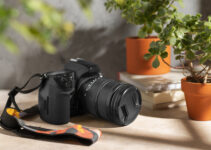Are camera bags considered carry on? It’s a question that many travelers ponder as they pack for their journeys.
With airlines’ ever-changing policies, understanding what qualifies as carry-on luggage can save you time and stress at the airport.
In short, yes, camera bags are typically considered carry-on items. However, there are size and weight restrictions that vary among airlines.
Knowing these guidelines beforehand ensures a smoother travel experience with your photography gear safely stowed.
Curious to delve deeper into the specifics of carry-on rules for camera bags?
Our upcoming article breaks down airline policies, offers expert insights from seasoned travelers, and provides practical tips for hassle-free air travel with your photography equipment.
Are camera bags considered carry on?
Yes, camera bags are typically considered carry-on items when traveling by air.
However, there are a few important considerations to keep in mind:
- Size Restrictions: Airlines have specific size limitations for carry-on bags. Camera bags should generally comply with these dimensions to be allowed as carry-ons.
- Weight Limits: In addition to size, airlines also impose weight restrictions on carry-on luggage. Ensure that your camera bag, along with its contents, does not exceed the specified weight limit.
- Security Screening: Camera equipment, especially larger lenses and tripods, may require additional screening at airport security checkpoints. Be prepared to remove these items from your bag for inspection.
- Valuable Items: Since camera gear can be expensive and fragile, it’s advisable to keep it with you as a carry-on rather than checking it in to minimize the risk of damage or theft.
Overall, while camera bags are generally allowed as carry-on items, travelers should be aware of and adhere to airline policies regarding size, weight, and security screening.
Here, a mode camera bag.
Is a camera bag considered a personal item?
Can i carry my camera around my neck on a plane?
Yes, you can carry your camera around your neck on a plane. However, there are a few things to keep in mind:
- Security Check: During security screening, you may need to remove your camera from around your neck to pass it through the X-ray machine separately. This is to ensure a clear view of the camera and its components.
- Comfort and Safety: While it’s convenient to have your camera easily accessible, consider the weight and size of your camera. A heavy or bulky camera may become uncomfortable during a long flight, so you may want to stow it in your carry-on bag when not in use.
- Consideration for Others: Be mindful of your surroundings, especially in crowded areas like the boarding gate or during the flight. Avoid swinging your camera around or causing inconvenience to fellow passengers.
Overall, carrying your camera around your neck on a plane is generally allowed, but it’s essential to be mindful of security procedures, comfort, and consideration for others.
Camera backpack count as “personal item” on flight
Can all of this count as a personal item? Carry on Suitcase + Backpack + Camera bag?
Typically, airlines allow passengers to bring one carry-on suitcase and one personal item onboard.
Whether your carry-on suitcase, backpack, and camera bag can all count as personal items depends on their size, the airline’s policies, and how you pack them.
- Carry-On Suitcase: This is usually your main luggage that goes in the overhead bin. It must meet the airline’s size and weight requirements for carry-ons.
- Backpack: If your backpack is small enough to fit under the seat in front of you and does not exceed the airline’s size restrictions for personal items, it can usually count as your personal item.
- Camera Bag: Similarly, if your camera bag is compact and complies with the airline’s size limits for personal items, it can also count as your personal item.
However, it’s essential to check the specific policies of the airline you’re flying with, as some may have stricter guidelines or may require you to consolidate your personal items into one bag if space is limited.
Here, DIY camera bag.
Camera bag that passes as a “personal item”
A camera bag can often pass as a “personal item” when traveling, especially if it meets certain criteria:
- Size: The camera bag should comply with the airline’s size restrictions for personal items, typically smaller than carry-on luggage and able to fit under the seat in front of you.
- Contents: The bag should primarily contain personal items related to your travel, such as camera gear, electronics, documents, and essentials you may need during the flight.
- Utility: A camera bag that doubles as a personal item is advantageous because it keeps your valuable camera equipment close to you, ensuring safety and easy access during the journey.
- Comfort: Opt for a camera bag that is comfortable to carry, especially if you’ll be moving around the airport or during the flight.
By choosing a camera bag that meets these criteria, you can efficiently utilize it as a personal item while traveling, allowing you to carry your camera gear conveniently and securely.
Travel cases, camera bags for airline carry on?
When it comes to airline travel, choosing the right travel case or camera bag for carry-on purposes is crucial.
Here are some considerations:
- Size and Dimensions: Ensure that the travel case or camera bag meets the airline’s size restrictions for carry-on luggage. This typically means the bag should fit within specific dimensions to be stowed in the overhead compartment or under the seat.
- Durability and Protection: Opt for a travel case or camera bag that offers adequate protection for your equipment. Look for padded compartments, sturdy materials, and features like water resistance to safeguard your gear during transit.
- Organization: Choose a bag with sufficient compartments and pockets to organize your camera, lenses, accessories, and personal items effectively. This helps streamline security checks and keeps your essentials easily accessible.
- Comfort: Consider the bag’s comfort features, such as padded straps or handles, especially if you’ll be carrying it for extended periods within the airport or during the flight.
By selecting a travel case or camera bag that meets these criteria, you can ensure a smooth and hassle-free experience while traveling with your photography equipment.
Here, 1o best canon camera bag.
Does my SLR camera count as hand luggage?
Yes, your SLR (Single Lens Reflex) camera typically counts as hand luggage when traveling by air.
Most airlines consider cameras and other photographic equipment as personal items or carry-on luggage.
However, there are a few important points to consider:
- Size and Weight: Airlines have specific size and weight restrictions for carry-on luggage. Ensure that your camera, along with any attached lenses or accessories, complies with these limitations.
- Security Screening: You may be required to remove your camera from its bag during security screening at the airport. Be prepared to present it separately for inspection.
- Protection: To protect your camera from damage, consider using a padded camera bag or case designed for travel. This not only keeps your equipment safe but also helps organize additional accessories like batteries, memory cards, and chargers.
- Valuables: Due to their value and fragility, it’s advisable to keep SLR cameras and related gear with you as carry-on luggage rather than checking them in to minimize the risk of loss or damage.
Always check with your airline for specific guidelines regarding cameras and hand luggage to ensure a smooth travel experience with your SLR camera.
How much weight can i carry on a plane?
The weight limit for carry-on luggage on a plane varies depending on the airline and travel class.
Generally, most airlines allow passengers to bring one carry-on bag and one personal item (such as a backpack or laptop bag) into the cabin.
The weight limit for carry-on bags typically ranges from 7 kg (15 lbs) to 10 kg (22 lbs) for economy class passengers.
Premium and business class passengers may have higher weight allowances, often around 10 kg (22 lbs) to 15 kg (33 lbs).
However, these limits can vary widely, so it’s crucial to check with your specific airline before your flight.
Exceeding the weight limit for carry-on luggage may result in additional fees or the need to check the bag at the gate.
To avoid complications, weigh your carry-on bag before heading to the airport and pack only essential items to stay within the allowed weight limit.
Packing For Your Flight
Packing for your flight involves strategic planning to ensure a smooth and enjoyable travel experience.
Here are some tips for efficient packing:
- Check Airline Policies: Familiarize yourself with your airline’s baggage policies, including size and weight restrictions for carry-on and checked luggage.
- Essentials First: Pack essential items such as travel documents, medications, and valuables in your carry-on bag to keep them easily accessible.
- Clothing Selection: Choose versatile clothing items that can be mixed and matched to create different outfits. Consider the weather at your destination and pack accordingly.
- Toiletries: Pack travel-sized toiletries in a clear, resealable bag to comply with airport security regulations. Remember the 3-1-1 rule for liquids, gels, and aerosols.
- Electronics: Pack electronics such as laptops, cameras, and chargers in your carry-on bag. Consider using a padded case to protect these items.
- Space-Saving Techniques: Utilize packing cubes, roll clothes instead of folding, and use compression bags to maximize space in your luggage.
- Travel Comfort: Pack travel essentials like a neck pillow, eye mask, earplugs, and snacks to enhance your comfort during the flight.
By following these packing tips, you can streamline your travel preparations and ensure a hassle-free journey.
TSA Essential Guidelines
Airline Restrictions
Airline restrictions encompass a wide range of rules and regulations that passengers must adhere to when traveling by air. Some common airline restrictions include:

- Baggage Allowance: Airlines specify the size, weight, and number of bags allowed for both carry-on and checked luggage. Exceeding these limits may result in additional fees.
- Restricted Items: Airlines prohibit certain items from being carried onboard, such as firearms, explosives, sharp objects, and flammable materials. These items may be allowed in checked luggage under specific conditions.
- Liquids and Gels: Passengers must comply with the TSA’s 3-1-1 rule for liquids, gels, and aerosols in carry-on bags, limiting them to containers of 3.4 ounces (100 milliliters) or less, all fitting in a quart-size resealable bag.
- Special Items: Airlines may have restrictions on transporting special items like sports equipment, musical instruments, and pets. Passengers should check with the airline for specific guidelines and any associated fees.
- Seat Selection: Some airlines may restrict certain seats or cabin classes based on fare type, loyalty status, or availability.
Understanding and following airline restrictions helps ensure a smooth and compliant travel experience for passengers.
How does someone take a lot of camera gear on a plane
Taking a lot of camera gear on a plane requires careful planning and adherence to airline policies.
Here are some strategies to manage a significant amount of camera equipment during air travel:
- Choose the Right Bag: Invest in a durable and spacious camera bag or case designed for travel. Look for compartments, dividers, and padding to organize and protect your gear.
- Pack Strategically: Prioritize essential camera equipment such as camera bodies, lenses, and batteries. Pack fragile items securely and use protective wraps or cases for extra protection.
- Maximize Carry-On Allowance: Utilize your carry-on baggage allowance to the fullest extent. Select a camera bag that meets airline size restrictions for carry-ons and can fit under the seat or in the overhead bin.
- Check Additional Options: Some airlines offer special allowances or fees for oversized or additional carry-on items, including camera gear. Check with the airline for options and any associated costs.
- Be Prepared for Security: Expect additional screening for camera gear at airport security checkpoints. Keep your gear easily accessible for inspection to expedite the process.
By following these tips and planning ahead, you can effectively transport a lot of camera gear on a plane while complying with airline regulations and ensuring the safety of your equipment.
Related faq’s
Do i have to take my camera out of my bag at the airpot?
Yes, you typically need to remove your camera from your bag at airport security checkpoints.
This allows security officers to get a clear view of the camera and its components during the X-ray screening process.
Removing the camera helps expedite the security check and ensures a thorough inspection if needed.
Additionally, items such as camera lenses, tripods, and batteries may also need to be removed from the bag for separate screening.
It’s advisable to check the specific security procedures of the airport you’re departing from to be prepared and avoid any delays during the screening process.
Can i carry DSLR camera in cabin baggage?
Yes, you can typically carry a DSLR camera in your cabin baggage when traveling by air.
DSLR cameras are considered personal items or carry-on luggage, subject to the airline’s size and weight restrictions.
It’s advisable to pack your DSLR camera securely in a padded camera bag or case to protect it during the flight.
However, be aware that some airlines may have specific guidelines regarding electronic devices,
Thus, so it’s recommended to check with your airline before your flight to ensure compliance with their policies and avoid any issues at the airport.
Can I take a camera bag as carry-on?
Yes, you can typically take a camera bag as carry-on luggage when traveling by air.
Camera bags are considered personal items or carry-on items, subject to the airline’s size and weight restrictions.
It’s important to choose a camera bag that complies with the airline’s guidelines for carry-on luggage, which often include dimensions that allow the bag to fit in the overhead bin or under the seat in front of you.
Additionally, ensure that your camera bag contains only items allowed in carry-on luggage, such as camera equipment, electronics, and personal essentials, to avoid any issues during security screening.
Do cameras have to be taken out for TSA?
Yes, cameras usually have to be taken out of bags and placed separately in a bin during TSA (Transportation Security Administration) screening at airports.
This allows TSA officers to get a clear X-ray image of the camera and its components.
Additionally, larger camera equipment such as lenses, tripods, and batteries may also need to be removed from the bag for separate screening.
Following these procedures helps ensure efficient and thorough security checks.
It’s advisable to check the specific guidelines of the TSA or the airport you’re traveling from to be prepared and avoid any delays during the screening process.
Where should I pack my camera when flying?
When flying, it’s best to pack your camera in your carry-on baggage rather than checking it in.
This ensures that your camera is with you throughout the journey, minimizing the risk of damage or loss.
Use a padded camera bag or case to protect your camera and its accessories. Keep valuable items such as camera bodies, lenses, and memory cards in your carry-on to prevent theft or mishandling.
Additionally, consider packing a spare battery and charger in case you need them during the flight. These precautions help ensure that your camera is safe and accessible during your travels.
How do you pack a camera bag for travelling
Small camera” carry-on luggage allowance
Most airlines allow small cameras to be carried as part of your carry-on luggage allowance.
However, it’s essential to check the specific size and weight restrictions set by your airline.
Small cameras, such as compact digital cameras or mirrorless cameras, are typically considered personal items and can be stored in your carry-on bag.
Ensure that your camera fits within the airline’s dimensions for carry-on items, usually around 22 x 14 x 9 inches (55 x 35 x 23 cm).
Additionally, keep in mind any restrictions on lithium batteries, which may need to be carried in your carry-on bag due to safety regulations.
Conclusion:
Yes, camera bags are generally considered carry-on items when traveling by air.
They are designed to fit within the size and weight limits imposed by airlines for carry-on luggage.
It’s essential to check specific airline policies to ensure compliance and avoid any issues during travel.








